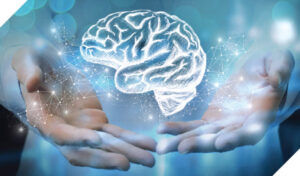 Through quarantines, shelter in place, social distancing, wearing face masks, economic strains, school closures and lots and lots of stress, your brain has been handling the pressure from the pandemic without issue. However, in the past month, without a specific cause, your brain may have been struggling. Why does it seem like it’s happening all of sudden? We are past month 4 of our new “normal”, so why is July so tough? Why is anxiety and depression and maybe even headaches, happening with more frequency when stress levels are not peaking?
Through quarantines, shelter in place, social distancing, wearing face masks, economic strains, school closures and lots and lots of stress, your brain has been handling the pressure from the pandemic without issue. However, in the past month, without a specific cause, your brain may have been struggling. Why does it seem like it’s happening all of sudden? We are past month 4 of our new “normal”, so why is July so tough? Why is anxiety and depression and maybe even headaches, happening with more frequency when stress levels are not peaking?
The answer is simple….INFLAMMATION. The summer months, heat and humidity create an enormous amount of blood flow in our bodies and most import, our brains. But what exactly is inflammation?
The term for opening of capillaries and increased flow of blood is called vasodilation. Capillaries open and an increase in blood flow occurs in the area. An area of injury may visibly swells up and we describe the area as “swollen” or “inflamed”. In the case of body temperature, “when we are too hot, blood vessels supplying blood to the skin can swell or dilate (vasodilation). This allows more warm blood to flow near the surface of the skin, where the heat can be lost to the air.” After healing or a reduction in body temperature, the capillaries return to normal through a process called vasoconstriction. This process is happening on an almost consistent basis during the summer months when temperatures can reach into the 90’s to 100’s, even in the evenings and early mornings.
If the capillaries do not close or do not close fast enough, we help them along. We apply ice (constricting the capillaries) or take a medication that reduces inflammation (such as ibuprofen) or promotes vasoconstriction (such as caffeine).
But, what happens to our heads if our body temperature rises, we experience vasodilation, but then do not experience vasoconstriction? A headache occurs. This is the result of increased blood flow we can feel through pain receptors covering the brain or scalp.
What if there is increased blood flow in our actual brain? This part of our body does not have pain receptors. Our brain doesn’t technically “feel” pain. The result of increased blood flow in the brain that does not constrict is what we call Brain Inflammation.
What are some causes of vasodilation or increased blood flow in the brain?
Heat or increased body temperature
Inflammatory foods such as Gluten or Dairy
Traumatic Brain/Head injuries
Concussions
Viruses such as Lyme
Medications such as Antibiotics or Anesthesia
Illness, Sinus irritation or colds/flu
What happens if there is increased blood flow (inflammation) in a part of the body that we cannot see?
After vasodilation or increases in blood flow, the brain, just as with other parts of the body should enter a period of vasoconstriction where blood flow decreases. If this does not happen, the blood flow or swelling remains. Unlike swelling in a wrist or ankle, the swelling that remains in your brain is not easily observed. Our first indication that we have increased blood flow that is not constricting is from symptoms.
Some of the symptoms that result from Brain Inflammation are:
Depression
Anxiety or related disorders
Brain Fog
Fatigue
Trouble with memory
Trouble with concentration
Trouble with learning
New allergies or sensitivities to food
Headaches
Irritability
Increased pain
Insomnia or sleep problems
How do I fix brain inflammation?
Because we cannot see increased blood flow in the brain without special equipment, it can be difficult to know it is happening. As mentioned earlier, there are not pain receptors in the brain so we don’t have pain to indicate swelling or inflammation. Typically, we notice symptoms that do not seem to resolve as an indication that there’s a problem that needs to be fixed. There are medications that can provide some relief. However, when we are prescribing medication based solely off of symptoms, you can easily end up on the wrong medication track and not receive relief. Natural anti-inflammatory supplements can also provide relief as well as an adjustment to diet or change in lifestyle. However we recommend an evaluation and EEG study to confirm the inflammation and then suggest the appropriate treatment options for your situation.
What is an EEG study?
An EEG study or QEEG (Quantitative EEG) is also called a brain map and does just that…it gives us a map of what is going on with the entire brain at one time. We attach electrodes to the whole head, 19 spots, and then record the brain waves with eyes open for 5 minutes and with eyes closed for 10 minutes. This recording is then sent to be read and analyzed. We provide a summary of significant findings and the report shows the result of analyzing the data several different ways. The brain activity is not only compared spot by spot over the entire head, but we can also look at connections, symmetry, how different parts are communicating and all of this data is compared to a database of peers (same sex, handedness and age). It can help us see what areas of the brain have increased blood flow by indicating what areas of the brain have excessive amounts of slower neuron activity (slow neurons promote more blood flow). Another study that can be helpful is the SPECT scan.
How can Neurofeedback help?
Once the areas of inflammation or dysregulation are identified, we use Neurofeedback or EEG Biofeedback to balance the neural patterns and reduce excessive slow activity. Teaching the brain to reduce these waves will help the brain to slow down increases in blood flow and return the brain to a more balanced and flexible state, thus relieving symptoms.
What is neurofeedback?
Neurofeedback, also known as EEG biofeedback, has been studied and practiced since the late 60’s. It is exercise for your brain by allowing you to see the frequencies produced by different parts of your brain in real-time and then through visual and auditory feedback, teaches the brain to better regulate itself. Neurofeedback can be used to help detect, stimulate, and/or inhibit activity in the brain safely and without medication. It can help restore a wider “range of motion” in brain states, much like physical therapy does for the body.
While the client sits comfortably watching a movie or pictures appear on the screen (a calm and focused state), the EEG equipment measures the frequency or speed at which electrical activity moves in the areas where electrodes have been placed. This information is sent to the therapist’s computer. The therapist is then able to determine what frequencies are out of balance. For example, when the EEG shows that you are making too many “slow” or “sleepy” waves (delta/theta) or too many “fast” waves (high beta), the therapist adjusts a reward band to encourage more balanced activity. This encouragement or “reward” happens through visual recognition of the changes on the screen and the auditory reinforcement of “beeps”.
It is important to understand that the neurofeedback approach does not “cure” or “fix” anything. We teach and guide your brain to produce frequencies which help it relax and/or focus. We provide the brain with gentle “challenges” and encouragement in a user-friendly, stress-free format so it learns to regulate or shift to healthier states more smoothly on its own at the appropriate time.
How does a “beep” or sound train my brain to work better?
The auditory or sound reward that corresponds to an increase or decrease in desired brainwave activity is able to affect the brain on a neurological level. Auditory reward stimulates auditory pathways, impacts the vestibular system, and has many connections to the reticular activating system, which modulates wakefulness and attention. These systems operate in our brains without conscious effort. Therefore, neurofeedback teaches your brain through automated learning with little or no behavioral effort. Another way to say this is that neurofeedback involves operant conditioning or learning. This type of learning teaches us through a reinforced reward system. The auditory reward (beep) is delivered on a schedule of reinforcement that promotes optimal learning; not too hard and not too easy. This schedule of reinforcement or reward provides just the right amount of resistance to evoke a positive learning pattern.
Why train your brain?
Mental clarity improves when you operate a calmer, more efficient brain. As you learn to slow down “inner chatter” or activate a “sleepy” brain, you become more effective at responding to stress and adapt more readily to different situations, both psychologically and physically. Parenting becomes less exhausting, appointments are more easily kept, decision-making improves, and mood swings and depression often lift.
Neurofeedback has also been shown to be of remarkable value with school-age children who experience focus and learning problems. Through brain training, children can learn to better concentrate on schoolwork, increase their frustration tolerance level, and are less prone to be overwhelmed with sensory overload while seated in a noisy classroom. With their thoughts more organized, they can focus more clearly on what others say to them and can begin to develop friendships and learn effectively.
What types of conditions does neurofeedback help?
Symptoms of these conditions, among others, can improve through neurofeedback training:
• Anxiety • Sleep disorders • Depression
• ADD/ADHD • Sensory processing disorder
• Bipolar disorder • Seizure disorders
• Auditory/visual processing
• Chronic pain/Fibromyalgia • Migraines/headaches
• Traumatic brain injuries • Stroke
• Cognitive decline • Peak performance
• Oppositional defiant disorder • Rages/mood swings
• Attention/focus/concentration
• Reactive attachment disorder
• Autism/Asperger’s
• Learning disabilities
• Obsessive compulsive disorder
How do I get started?
Getting started is easy, just give us a call. The Brain and Wellness Center staff will answer all of your questions, and help you get scheduled. If you are wondering what services are best for you? We can help determine that at the time of the intake, in a telephone consultation, or you can schedule a face to face consultation and see our facility.
Call, email or message us today!
Brain and Wellness Center
7301 W. Palmetto Park Rd., Suite 102A,
Boca Raton, FL 33433.
(561) 206-2706,
e-mail us at info@bocabraincenter.com,
or text us at (561) 206-2706
or visit our website at www.BocaBrainCenter.com.
 South Florida Health and Wellness Magazine Health and Wellness Articles
South Florida Health and Wellness Magazine Health and Wellness Articles




